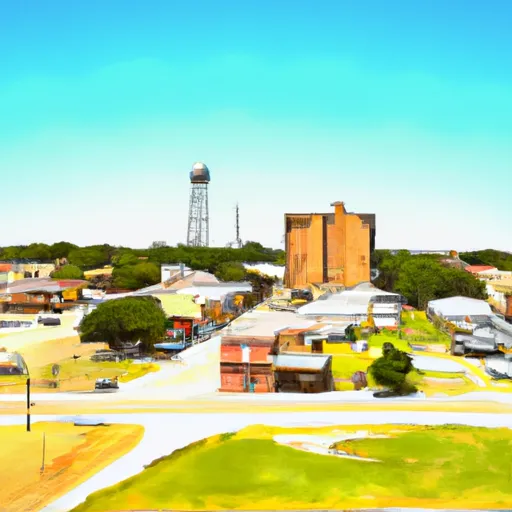-
 Snoflo Premium
Snoflo Premium
Get unlimited access to all our content
With no Ad interruptions! - Start Your Free Trial Login with existing account
Thrall
Eden Index
Climate
8.3
•
Recreation
4.4
•
Community
2.2
•
Safeguard
5.4/10

Thrall, Texas is a small rural community located in Williamson County. It has a humid subtropical climate, characterized by hot, humid summers and mild winters. Summers are typically hot with temperatures averaging in the high 90s°F (around 35°C), while winters are mild with temperatures averaging in the 60s°F (around 15°C). The area receives moderate rainfall throughout the year, with the wettest months being May and October.
Hydrologically, Thrall is situated in the Blackland Prairie region, which is known for its fertile soil. The area is drained by small creeks and streams, with Brushy Creek being the most prominent waterway in the region.
Thrall offers various outdoor recreation opportunities. The nearby Brushy Creek Regional Trail is a popular destination for hiking, biking, and horseback riding. It spans around 10 miles and features scenic views, picnic areas, and opportunities for wildlife observation. Fishing enthusiasts can enjoy casting a line in nearby lakes and ponds, such as Lake Granger and Lake Georgetown, which are known for their abundant catfish, bass, and sunfish populations. Overall, Thrall provides a tranquil setting for outdoor enthusiasts to enjoy nature and engage in recreational activities.
What is the Eden Index?
The Snoflo Eden Index serves as a comprehensive rating system for regions, evaluating their desirability through a holistic assessment of climate health, outdoor recreation opportunities, and natural disaster risk, acknowledging the profound impact of these factors on livability and well-being.
Climate Health Indicator (CHI): 8.3
Thrall receives approximately
865mm of rain per year,
with humidity levels near 85%
and air temperatures averaging around
20°C.
Thrall has a plant hardyness factor of
8, meaning
plants and agriculture in this region tend to thrive here all year round.
By considering the ideal temperature range, reliable water supplies, clean air, and stable seasonal rain or snowpacks, the Climate Health Indicator (CHI) underscores the significance of a healthy climate as the foundation for quality living.
A healthy climate is paramount for ensuring a high quality of life and livability in a region, fostering both physical well-being and environmental harmony. This can be characterized by ideal temperatures, reliable access to water supplies, clean air, and consistent seasonal rain or snowpacks.
Weather Forecast
Streamflow Conditions
Little
Area Rivers
Little
Snowpack Depths
Little
Reservoir Storage Capacity
Little
Groundwater Levels
Recreational Opportunity Index (ROI): 4.4
The Recreational Opportunity Index (ROI) recognizes the value of outdoor recreational options, such as parks, hiking trails, camping sites, and fishing spots, while acknowledging that climate plays a pivotal role in ensuring the comfort and consistency of these experiences.
Access to outdoor recreational opportunities, encompassing activities such as parks, hiking, camping, and fishing, is crucial for overall well-being, and the climate plays a pivotal role in enabling and enhancing these experiences, ensuring that individuals can engage in nature-based activities comfortably and consistently.
Camping Areas
| Campground | Campsites | Reservations | Toilets | Showers | Elevation |
|---|---|---|---|---|---|
| Buescher State Park | 65 | 337 ft | |||
| Yoakum City Park | 25 | 341 ft | |||
| Vernon L Richards Riverbend Park | 19 | 302 ft | |||
| Green Dickson Park | 12 | 370 ft | |||
| North Shore Park - Lake Bastrop | 17 | 463 ft | |||
| Cuero City Park | 10 | 214 ft | |||
| South Shore Park - Lake Bastrop | 38 | 468 ft | |||
| Hub City RV Park | None | 311 ft | |||
| Bastrop State Park | 78 | 524 ft | |||
| Independence City Park | 21 | 270 ft |
Nearby Fishing
Nearby Ski Areas
Catastrophe Safeguard Index (CSI):
The Catastrophe Safeguard Index (CSI) recognizes that natural disaster risk, encompassing floods, fires, hurricanes, and tornadoes, can drastically affect safety and the overall appeal of an area.
The level of natural disaster risk in a region significantly affects safety and the overall livability, with climate change amplifying these risks by potentially increasing the frequency and intensity of events like floods, fires, hurricanes, and tornadoes, thereby posing substantial challenges to community resilience and well-being.
Community Resilience Indicator (CRI): 2.2
The Community Resilience Indicator (CRI) recognizes that education, healthcare, and socioeconomics are crucial to the well-being of a region. The CRI acknowledges the profound impact of these elements on residents' overall quality of life. By evaluating educational resources, healthcare accessibility, and economic inclusivity, the index captures the essential aspects that contribute to a thriving community, fostering resident satisfaction, equity, and social cohesion.

